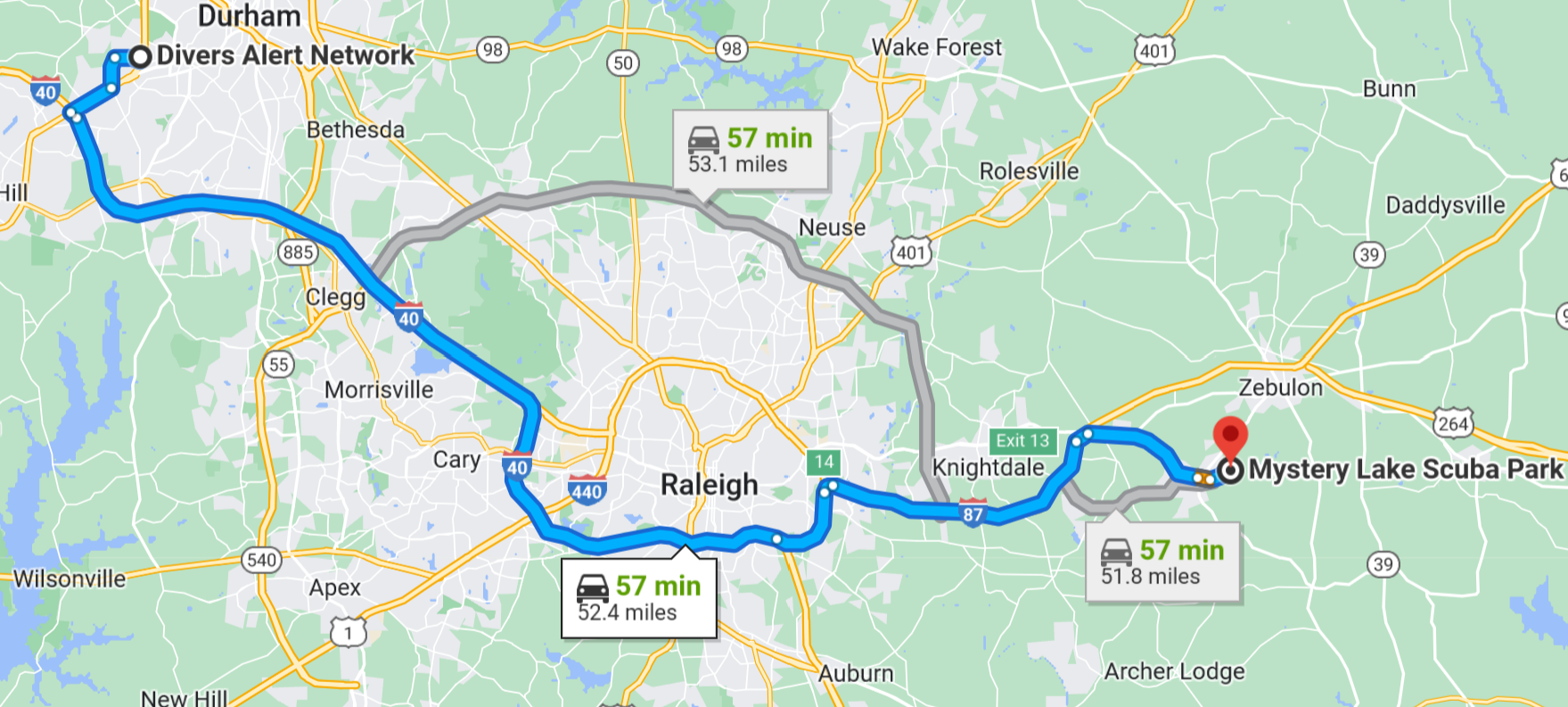Initially, my reaction to working every Saturday with the DAN research team was probably similar to most who are accustomed to having weekends off — “So… every Saturday?” But my outlook quickly changed after having the opportunity to be a part of what I feel is a critical step toward our understanding of individual variability in decompression stress, which is something that concerns all divers. In other words, why do some people get decompression sickness (DCS) when others don’t, even when diving similar dive profiles? This was a focus of the DAN research team’s primary bubble study for which I helped both as a researcher and participant. It also undoubtedly helped that it was an excuse to go diving every Saturday.

A map of the drive out to Mystery Lake

Myself and fellow interns bubble watching during the study at Mystery Lake.
Before I go further, I think it is useful to explain why bubbles (specifically venous gas emboli) are important when discussing decompression stress. As you may know from an open water class, DCS is a known risk of scuba diving and is currently managed by adhering to no-decompression limits, or decompression schedules, and slow ascent rates dictated by decompression models. DCS in diving is caused by dissolved gasses that form bubbles as they come out of solution due to a decrease in pressure on ascent.
What you may not know, or at least I didn’t know before my internship, is that bubbles can still form without the presence of “clinical DCS.” These bubbles are also known as venous gas emboli (VGE) and are detectable using ultrasound imaging. VGE provide a marker of decompression stress and have been associated with the probability of DCS (although it is not a direct relationship). Interestingly, like DCS, VGE appear at different rates both for different divers and for the same diver on different days. This could be due to a variety of factors, including hydration levels, inflammatory status, nutrition, age, sex, and weight to name a few.

Myself debriefing with Dr. Frauke Tillmans after a dive as a participant in the study
With all that in mind, the way that we investigated VGE differences between divers and within divers was by having a standard dive profile in a local quarry called Mystery Lake over the course of 6 weeks.

Pictured is the visibility at Mystery Lake (I promise that the image has loaded in correctly)
We also take some anthropomorphic measures (i.e., measures of body size), blood (for signs of inflammation), saliva (for stress and other factors), urine (for hydration status) and a 24-hour dietary recall. It was interesting to take part in the study from both the perspective of a researcher and a participant because you feel more empathy for some of the measures: namely the pinching from the caliper body fat measurements and the frustration of forgetting to log your meals from the previous day. Before and after each dive, we would take ultrasound images of participants’ hearts. While I can’t speak to the results of the study (because DAN will still be recruiting and collecting data for at least a few more years), I can speak to some of the interesting anecdotal results we had.

DAN Research team members taking some ultrasound measurements on a participant
There was evident variation in bubbling depending on the dive and the diver. For instance, I did not show much bubbling (if any) on any of my six dive days. In contrast, my colleague bubbled every single dive and for varying lengths post-dive (up to 3 hours later). A different participant noted anecdotally that they think they bubbled more on weeks where they were menstruating, which could be an interesting finding if further investigated, especially given the lack of representation of women in most scientific research (not excluding dive physiology research).
All in all, I was not at all disappointed to have “lost” my Saturdays to DAN’s new bubble study, because it was an opportunity to really contribute to some of the early research that may one day lead us to more personalized decompression models and safer diving. I’m excited to hear more about the upcoming findings over the next few years, and I hope that it was interesting to hear a bit about DAN’s new bubble study! If you’re in the Durham, North Carolina, area, DAN is still recruiting. Volunteering to participate in the study is not only a chance to help advance dive safety and science, but it’s also an excuse to have a great time with great people and go diving (for free) for six weekends.

DAN Research Team Members at Mystery Lake. From left to right Front Row: Enya Marx, Katherine Eltz, Virginie Papadopoulou Back Row: Myself, Robert Furberg, Gabe Graf, Shannon Sunset, Rhiannon Brenner, David Charash, Grant Dong

